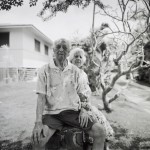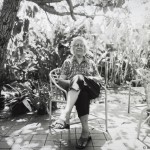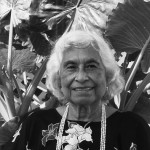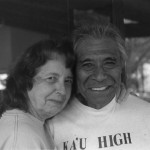Nānā i ke kumu.
Look to the source. Utilize various sources (i.e. kupuna, kumu, loea, moʻolelo, wahi pana, moʻomeheu) to foster inquiry and seek knowledge.
OVERVIEW:
At this point in the class, you are skilled in using the camera and the darkroom to make pictures. Previous projects have been assigned to expose you to different elements and techniques in photography. Now it’s time for you to start putting everything you know to make images that are meaningful to you!
For this project, you will be arranging a shoot with a family member and making portraits of them. Think about someone you don’t spend a lot of time with or someone you admire, like a kupuna. Think about what it is you want to communicate about this person and how lighting, focus, and composition can play a roll in capturing that message. The whole point of this assignment isn’t just to capture their face, but to spend time with this person, learn something about them, and create meaningful images.
Since some of you are borders or may not have access to family members at all times, think about what “family” or “‘ohana” means to you. Is family only blood-relatives? What connects a family? What type of family do you belong to or want to belong to? Think about what family does for you – people who care for you, feed you, teach you, correct you? Who else represents these things to you outside of your family?
Be aware of all the things we’ve learned so far in photography, as your prints should demonstrate an understanding of camera operations, proper darkroom technique, an awareness of lighting and composition, as well as some kind of deeper meaning/message.
STUDENTS WILL BE ABLE TO:
- demonstrate an understanding of photography (camera operations & darkroom techniques)
- create meaningful work that they are proud of
- spend time with people from a different generation & learn from them
WHAT TO TURN IN
- ONE (1) Contact Sheet (24 images = 1 full sheet)
- TWO (2) 8″x10″ prints (full sheets now, not half sheets)
- ONE (1) completed Photo Evaluation
Project #6 (‘Ohana Portraits) and Project #7 (He Hawai’i Au) can be done in either order, but BOTH must be completed by the end of the semester.
Here are some of my photographs from a body of work “Kuʻu Kupuna” revolving around my Tutu and Papa.
“Each time I visited to photograph my grandparents, I found myself struggling with my inability to control time, not only as a photographer shooting shaky-limbed models with slow film and a large camera, but as a granddaughter wanting infinite moments with her aging grandparents. From this project, I learned to resist projecting my fear of the finite onto my grandparents and instead recognize the realities of aging; choosing to see the life and happiness within my grandparents.”
Below are links to other artists’ work that explore the aging process and family
Amy Luna: “I wanted to document basically everything that is prominent in my mind when I think of my grandparents, just to have in my heart forever…Everyday is not sunshine and rainbows, but they have shown me what it is to truly love through it all.”
Kent Nishimura: This photo project follows an elderly woman 10 years after the death of her husband. The photographs are an intimate look at loneliness and resilience and Nishimura has an amazing awareness of lighting and framing.
Jane Paradise: “When I Was Young, I Was Beautiful” tells the story of a 90+ year-old woman in her later years
Jodi Champagne: “The lines on a face can never lie. Lines formed up, down, left and right. With enough pressures in life, the lines are forced to be deeper, curved or bent. What causes these changes? Is it the environment, decades of wear and tear? Or are they the expressions of a soul? I’m fascinated by the stories that come from these lines of wisdom. Beauty is not always held in youth.”
EXAMPLES OF STUDENT WORK:
- Alaina Kedro, gr 10
- Chynna Tasaka, gr 10
- Chynna Tasaka, gr 10
- Katia Damazo, gr 12
- Tehya Taylor, gr 10
- Theresa Ahuna-Turqueza, gr 9
- Sage Manoa, gr 11
NATIONAL CORE ARTS STANDARDS
RESPONDING – HS Proficient VA: RE.7.1.Ia – Anchor Standard 7: Perceive and analyze artistic work.
Enduring Understanding: Individual aesthetic and empathetic awareness developed through engagement with art can lead to understanding and appreciation of self, others, the natural world, and constructed environments.
- How do life experiences influence the way you relate to art?
- How does learning about art impact how we perceive the world?
- What can we learn from our responses to art?












